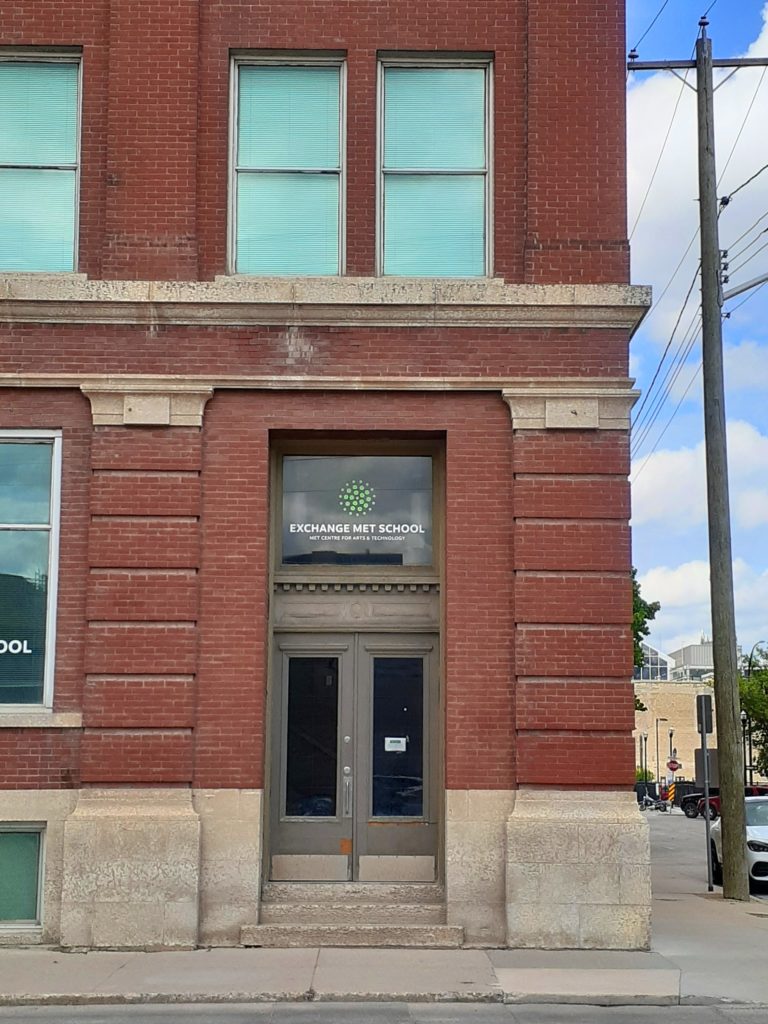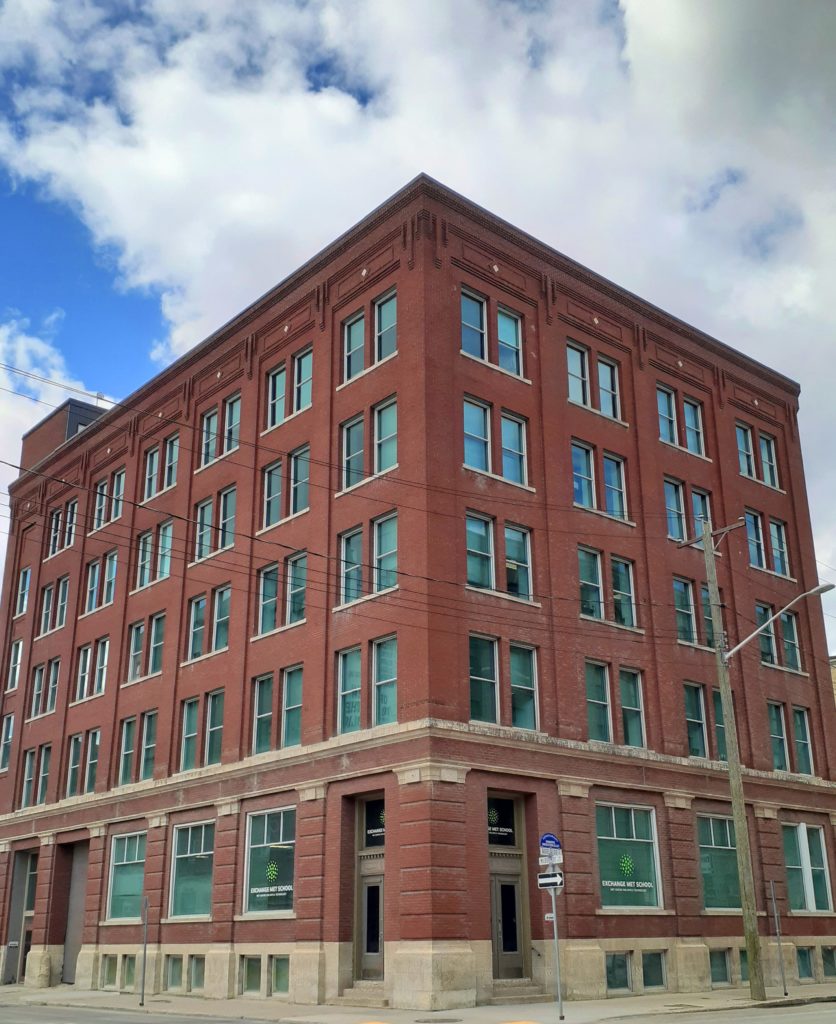
/ Blog
July 13, 2023
Building Futures: The Finnie And Murray Block
On the western edge of the Exchange District sits a handsome red brick warehouse, built at the height of Winnipeg’s early 20th century prosperity. While the exterior of the Finnie and Murray Block is nearly unaltered since it was constructed over 110 years ago, inside the changes have been dramatic, telling the story of a neighbourhood’s evolution. Once primarily used for manufacturing, the building has been transformed into a centre of learning and growth, where students now take the first steps towards becoming tomorrow’s community minded leaders.
The Finnie and Murray Manufacturing Company was established in 1910 as a wholesale manufacturer and importer of dry goods, men’s furnishings and smallwares. It was founded by David Nicholson Finnie of Ontario and George Coupar Murray of Quebec. The pair started their company by buying out the regional office of Woods Limited, a wholesale dry goods firm that Finnie was a managing director for in Winnipeg. The new business began operations at 86-88 Princess Street, in the Miller Morse Block.
In just two years of operations, the Finnie and Murray Manufacturing Company was so successful that it was able to erect its own building, a testament to the booming economy of Winnipeg prior to World War One. By this time, the Exchange District, which was once made up of muddy streets lined with small wooden buildings, had been transformed into the city’s warehouse district. The development was the result of the arrival of the Canadian Pacific Railway in Winnipeg in the early 1880s, the country’s first transcontinental line. With it the city became a hub of commerce, as raw materials where being shipped in from the west and manufactured goods where arriving from the east. Companies moving into the flourishing city chose to locate near Winnipeg’s most important buildings, namely City Hall on Main Street. Between 1900 and 1914, around $5 million was spent on the warehouses of the Exchange District by local, national and international firms.

The northwest corner of the intersection of McDermot Avenue and Main Street, between 1881 and 1886. When the transcontinental railway reached Winnipeg, the city became a booming metropolis with businesses flocking to this stretch of Main Street near City Hall.
Source: Rob McInnes Postcard Collection (Winnipeg Public Library)
As the Finnie and Murray Manufacturing Company was starting construction in 1912, it was near the end of this period of Winnipeg’s growth. Their new building, the Finnie and Murray Block at 321 McDermot Avenue, would be the first warehouse west of Adelaide Street, expanding the boundaries of the wholesale centre of Western Canada. The building was located so far out on the fringes of the Exchange District that a remnant of the area’s residential past, the 1882 Kelly House at 88 Adelaide Street, was still standing on the lot next door. As Winnipeg’s economy would grind to a halt a few short years after Finnie and Murray finished their building, few other warehouses would join them on the outskirts of the Exchange District, and Kelly House would remain standing. To this day it is a rare house in a neighbourhood surrounded by commercial buildings.
George W. Northwood was hired to design the Finnie and Murray Block, a five storey Edwardian style warehouse. Located at the corner of McDermot Avenue and Adelaide Street, the block had two handsome red Menomonie brick facades with ashlar limestone accents and subtle decorative brickwork below the roofline. Northwood was a prolific architect originally from Ottawa, who left an indelible mark on Winnipeg, designing many iconic buildings which still stand today, like the 1913 Ralph Connor House at 54 West Gate. Built at a cost of $81,500 by the Carter-Halls-Aldinger Company, the Finnie and Murray Block included offices, show rooms and manufacturing space.
In 1922, Finnie left the Finnie and Murray Manufacturing Company, to be replaced with G.C. Murray. The new partnership would continue to operate in the building as Murray’s Limited, eventually departing around 1926. A new business would then take ownership of the Finnie and Murray Block, Western Glove Works – a name still often associated with the building. Western Glove Works was established by the Silver family in 1921, through the purchase of a dry goods company, which grew to encompass all kinds of manufacturing – including gloves! They would share the Finnie and Murray Block with a variety of other companies over the years, including newspapers and other manufacturers.
While operations at the Finnie and Murray Block seemed to have been relatively uneventful, all was not so for Sol Silver, the manager of Western Glove Works. Around 9:45 am on Saturday, January 18th, 1936, Silver left the building and drove to the Canadian Bank of Commerce at the corner of Alexander Avenue and Main Street. A trip that he had been making every weekend for 15 years, Silver was picking up the company’s payroll. But unlike any other Saturday morning, on this day two men in overcoats, one carrying a weapon, got into Silver’s car along with him after he exited the bank with over $1,600 in cash in a black bag. Sitting on either side of Silver in the front seat, the criminals threw a blanket over Silver’s head, tied up his hands with wire and pushed him to the floor before speeding away.

Looking west down McDermot Avenue from Albert Street, between 1909 and 1917. Can you see if the Finnie and Murray Block has been built yet in this image? It would be located several blocks down the street on the right hand side.
Source: Rob McInnes Postcard Collection (Winnipeg Public Library)
Silver’s car came to a halt underneath the south end of the Slaw Rebchuk Bridge (Salter Street Bridge), where some reports say he was then thrown from the car. Regardless, this is where the criminals took the cash and departed on foot. Fortunately, Silver was able to escape the bondage relatively quickly and walk to a nearby grocery store to call the police. After going to the police station and making a full report of what had happened, Silver was headed back to the bank to try and pick up the payroll for Western Glove Works once again. The company was fully insured against the theft of the payroll, and Silver did not want his employees to go without that weekend. Undeterred by the event, Silver would go on to become the president of Western Glove Works before retiring from the company in 1962.
In the decades that followed Silver’s brazen kidnapping, the Finnie and Murray Block would start to evolve – an evolution that continues to this day. In the 1940’s, Western Glove Works phased out the production of gloves, shifting their focus to high end fashion. The 1950’s saw the start of interior alterations made to the Finnie and Murray Block, mostly taking place on the main floor in the beginning. Western Glove Works left the block in 1987, moving to Logan Avenue where they continue to operate successfully to this day – but the name stuck with the building at 321 McDermot Avenue after 60 years of being owned by the company. That same year, the Finnie and Murray Block became a designated heritage building, protecting it from demolition and ensuring all future renovations were sensitive to its historic characteristics. From 1988 to 1990 a string of interior alterations were made to the building, for which it was awarded a Commercial Conservation Award of Excellence by Heritage Winnipeg at our 5th Annual Preservation Awards in 1989.
Upgrades and renovations have continued inside the Finnie and Murray Block, with all sorts of tenants coming and going. In fall 2021, the MET Centre for Arts and Technology opened its doors in the building. The third Met school in Seven Oaks School Division, it is a publicly funded school that started with two grade nine and one grade 10 class, hoping to eventually have 150 students. Met schools are inspired by the Metropolitan Regional Career and Technical Center in Rhode Island, which in 1996 was the first school to implement the “Big Picture Learning” model. The motto of “Big Picture Learning” is “education is everyone’s business” – students and the community. Students are empowered to take charge of their own education, pursuing their interests through projects and working towards career goals. The community offers support through internships and hands-on learning experiences, mentoring students as they grow and learn.

The MET Centre for Arts and Technology in the Finnie and Murray Block at 321 McDermot Avenue in June 2023.
Source: Heritage Winnipeg
The new MET Centre for Arts and Technology in the Finnie and Murray Block is an excellent location for students to be based out of, with countless learning opportunities in the area that can be reached by foot. One of those nearby opportunities is with Heritage Winnipeg, where Met students have been interning for the past several years. The internships have resulted in engaging projects that showcase Winnipeg’s heritage and history through a variety of formats, and often culminate with the projects being presented at Doors Open Winnipeg. It is a wonderful arrangement for both the students and Heritage Winnipeg – students have the opportunity to pursue a project that interests them in a professional setting, while Heritage Winnipeg has the opportunity to inspire the next generation of heritage advocates.

Students from the MET Centre for Arts and Technology present their project on heritage at the Millennium Centre during Doors Open Winnipeg 2023.
Source: Heritage Winnipeg
The final goal of the MET Centre for Arts and Technology is to be much more than a school – a hub for the community. The school envisions the Finnie and Murray Block being open 18 hours a day, welcoming those interested in building a vibrant and democratic society. It is a transformation that is representative of changes that have taken place throughout the Exchange District in the past 100+ years. Once residential, the area transformed into warehouses which over time have been adaptively reused to better serve the community. Today they provide space for artists, small businesses, non profit organizations, tech companies, condominiums, professional firms, cafés, apartments and more. It is a diverse neighbourhood that thrives on its ability to make room for everyone to pursue what matters to them, transforming once empty warehouses to desirable destinations. Built on the fringes of the Exchange District at the end of the area’s building boom, the Finnie and Murray Block is now leading the way with its ability to adapt and its effort to nurture a new generation of Winnipeggers with an innovative approach to education. May the students at the MET Centre for Arts and Technology be just as prosperous as the companies who occupied the Finnie and Murray Block before them, walking in the footsteps of trailblazers!
THANK YOU TO THE SPONSOR OF THIS BLOG POST:

Written by Heritage Winnipeg.
SOURCES:
321 McDERMOT AVENUE – FINNIE MURRAY BLOCK (WESTERN GLOVE BUILDING) | City of Winnipeg - 1987
About | MET Centre for Arts & Technology
About Big Picture Learning | Big Picture Learning
George W. Northwood | Winnipeg Architecture Foundation
Our History | Western Glove Works
Payroll Bandits Kidnap Man and Get $1,600 Haul | The Winnipeg Evening Tribune - January 18, 1936
Pay-roll Bandits Make $1,600 Haul on City Streets | Winnipeg Free Press - January 20, 1936
Principal's Message | Will Burton - MET Centre for Arts & Technology
Seven Oaks School Division Met Schools | Seven Oaks School Division
Western Glove Works | Canada’s Historic Places













